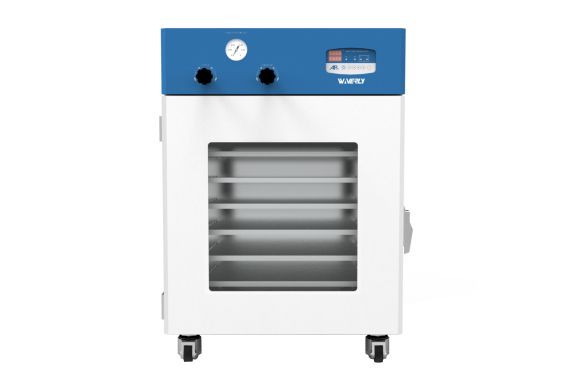
Waverly Vacuum Drying Ovens are laboratory-grade high quality vacuum ovens with superior performance and a lifetime warranty. They are built tough with the higest quality medical grade stainless steel and they have a solid base with almost no vibration or sound/noise. Excellent temperature uniformity and accuracy with extremely efficient vacuum flow for maximum throughput. Lined with LED lights on the interior sides so you can easily view your product on each shelf when the door is closed. This vacuum dryer oven is ideal for solvent removal and recovery! Pair it with the Waverly Cold Trap and Waverly Vacuum Pump for the fastest, easiest and the most effiecient solvent recovery system in the world.
Vacuum Oven:
A Vacuum Oven is a very versatile peice of equipment with applications in laboratory research, engineering, and industry. A vacuum drying oven is most often used for delicate drying processes, such as drying tiny parts or removing flammable solvents. The low pressure environment also minimizes oxidation during drying. Vacuum ovens work better than regular ovens beacuse they remove the source of contamination.
A standard vacuum oven can operate at temperatures as high as 200C to 250C. A rugged, high quality pressure chamber, gasket seals, and pump are features to look for, as well as convenient, programmable controls and a computer interface. Vacuum drying ovens are also available with specialized features such as solvent recovery or residual gas analysis to prevent over drying. For drying flammable solvents, look for a safety vacuum drying oven that has been approved for these types of applications.
Vacuum ovens can be used for many different puposes and may be referred to as a vacuum drying oven, vacuum dryer, vacuum furnace, purge oven, industrial vac oven, bho oven, solvent removal oven, solvent recovery, butane removal oven, etc.
Waverly vacuum ovens are the best choice for all types of laboratories because of their high-quality build, multi-use flexibility, and best-in-class performance for temperature stability, uniformity, and variation. Waverly Vacuum Ovens have a lifetime warranty and all the proper safety features and certifications that meet stringent safety requirements.
How it Works:
Vacuum Ovens are generally used with vacuum pumps to reduce the chamber pressure in order to maximize heat transfer and evaporation. Solvent vapors from the feed can be condensed back to a liquid with a condenser or cold trap to be collected and reused if desired. Once dried, the solid product is collected from the trays.
Where to use:
- Used to dry heat-sensitive hygroscopic and toxic materials
- To remove and recover solvent from a sovent saturated solution
- Drying materials which are difficult to handle in other dryers because of convenient tray arrangement inside the dryer.
Popular Industries:
Cannabis extraction
Vacuum ovens are a must have for all cannabis extraction applications no matter what end product you're making; BHO "dabs, shatter, ice", essential oil, purified THC, CBD, first pass, clear, edibles, flower, hash, kief, shatter/ice, tincture, topical, etc.
The primary purpose of a vacuum oven for cannabis extraction is to dry your product; to remove and collect the solvent and all other liquids from your mixture. It is designed to be used with a vacuum pump and it is recommended to be used with a condenser or cold trap in order to save and reuse the solvent.
Because of the negative pressure, heat isn't required to remove solvent, however heat can be applied if desired for decarboxylation (a chemical reaction that removes a carboxyl and releases CO2) which is required to 'activate' THC.
Electronics
During printed circuit board manufacturing, vacuum processing is used to cure coatings and dry the electronics. The boards are made of heat-sensitive plastics that would quickly shrink in a standard convection oven. By using a vacuum oven and reducing the pressure, epoxies can cure and water can be pulled out at nice, low temperatures. This allows the boards to be clean and dry as they move to the next phase of production. A bonus feature of a vacuum oven is drying wet electronics, such as a cell phone. Anything from a phone that was dropped into a toilet or a keyboard that was the victim of a spill can be dried quickly and at a low temperature in a vacuum oven. The same process works for watches with a bit of condensation under the lens. Any time you have water trapped where you don’t want it, a vacuum oven can help you liberate it and dry the item.
Medical devices
Even in clean manufacturing environments, product components are full of trapped chemicals. Some of these chemicals can be harmful to people if introduced into the body. Devices such as heart valves, artificial joints and catheters require vacuum processing prior to implantation. These devices are typically made of heat-sensitive resins that would be damaged in a high-temperature convection oven so vacuum processing is a must. All of the trapped chemicals in the devices would be left to leech out into the patient’s body if not first processed under a vacuum.
Aerospace
The aerospace industry relies heavily on vacuum technology for research and manufacturing. Before sending items into space, engineers need to know how they will behave in that vacuum. Vacuum vessels assist aerospace engineers by simulating the high vacuum environment of space so that the behavior of different widgets can be assessed prior to launch. Self-assembling satellites are frequently launched into space and then left on their own to unfold into the final array. The research and engineering that makes that possible requires simulated space environments — such as a vacuum oven — to perfect the process.
Meanwhile, everything that is going into space must be cured in a vacuum oven prior to launch. At atmospheric pressure this may not be an issue; however, as soon as a craft full of thousands of unique components is launched into space, those chemical substances all begin to off-gas. As these chemicals are released, they can mix and react. The reactions can cause fire, condensation or corrosion on the spacecraft. In order to prevent this, everything from wire harnesses to upholstery must be processed through a vacuum oven.
| Model | VV8G | VV27G | VV64G | VV125G | VV216G |
| Air Circulation type | Forced | Forced | Forced | Forced | Forced |
| Capacity | 8 Liters (0.3 cu.ft.) | 27 Liters (1 cu.ft.) | 64 Liters (2.3 cu.ft.) | 125 Liters (4.4 cu.ft.) | 216 Liters (7.6 cu.ft.) |
| No. of Shelves | 2 supplied (2 maximum) | 2 supplied (4 maximum) | 3 supplied (5 maximum) | 4 supplied (6 maximum) | 5 supplied (7 maximum) |
| Temp Range | Ambient +5°C to 250°C (Ambient + 9°F to 482°F) |
Ambient +5°C to 250°C (Ambient + 9°F to 482°F) |
Ambient +5°C to 250°C (Ambient + 9°F to 482°F) |
Ambient +5°C to 250°C (Ambient + 9°F to 482°F) |
Ambient +5°C to 250°C (Ambient + 9°F to 482°F) |
| Temp & Time Controller | PID Digital Controller 00.00 to 99HR 59MIN |
PID Digital Controller 00.00 to 99HR 59MIN |
PID Digital Controller 00.00 to 99HR 59MIN |
PID Digital Controller 00.00 to 99HR 59MIN |
PID Digital Controller 00.00 to 99HR 59MIN |
| Vacuum Resistance | 0 to 76 cmHg (0 to 0.1MPa) | 0 to 76 cmHg (0 to 0.1MPa) | 0 to 76 cmHg (0 to 0.1MPa) | 0 to 76 cmHg (0 to 0.1MPa) | 0 to 76 cmHg (0 to 0.1MPa) |
| Heater Capacity | 800 W | 800 W | 1500 W | 3000 W | 4500 W |
| Dimensions Internal (WxDxH) |
200×200×200(mm) 7.87x7.87x7.87(inch) |
300x300x300(mm) 11.81x11.81x11.81(inch) |
400x400x400(mm) 15.75x15.75x15.75(inch) |
500x500x500(mm) 19.69x19.69x19.69(inch) |
600x600x600(mm) 23.62x23.62x23.62(inch) |
| Dimensions External (WxDxH) |
385×315×555(mm) 15.15x12.40x21.85(inch) |
605x550x770(mm) 23.81x21.65x30.31(inch) |
705x620x870(mm) 27.75x24.80x34.25(inch) |
815x765x1050(mm) 32.08x30.11x41.33(inch) |
915x880x1150(mm) 36.02x34.64x45.27(inch) |
| Shipping Dimensions (WxDxH) |
850x770x1060(mm) 33.46x30.31x41.73(inch) |
970x900x1210(mm) 38.18x35.43x47.63(inch) |
1050x1000x1310(mm) 41.33x39.37x51.57(inch) |
||
| Net Weight | 29 kg | 69 kg | 100 kg (220 lb) | 200 kg (440 lb) | 281 kg (619 lb) |
| Shipping Weight | 150 kg (330 lb) | 280 kg (617 lb) | 371 kg (817 lb) | ||
| Material Internal | Stainless Steel | Stainless Steel | Stainless Steel | Stainless Steel | Stainless Steel |
| Material External | Steel Plate with Powder Heating Coat |
Steel Plate with Powder Heating Coat |
Steel Plate with Powder Heating Coat |
Steel Plate with Powder Heating Coat |
Steel Plate with Powder Heating Coat |
| Material Packing | Silicon Rubber Packing | Silicon Rubber Packing | Silicon Rubber Packing | Silicon Rubber Packing | Silicon Rubber Packing |
| Viewing Window | Tempered Glass | Tempered Glass | Tempered Glass | Tempered Glass | Tempered Glass |
| Electrical Requirement | 120V, 50/60 Hz, 1Φ, 6.6A | 120V, 50/60 Hz, 1Φ, 8.3A | 120V, 50/60 Hz, 1Φ, 12.5A | 120V, 50/60 Hz, 1Φ, 25.0A | 120V, 50/60 Hz, 1Φ, 37.5A |

